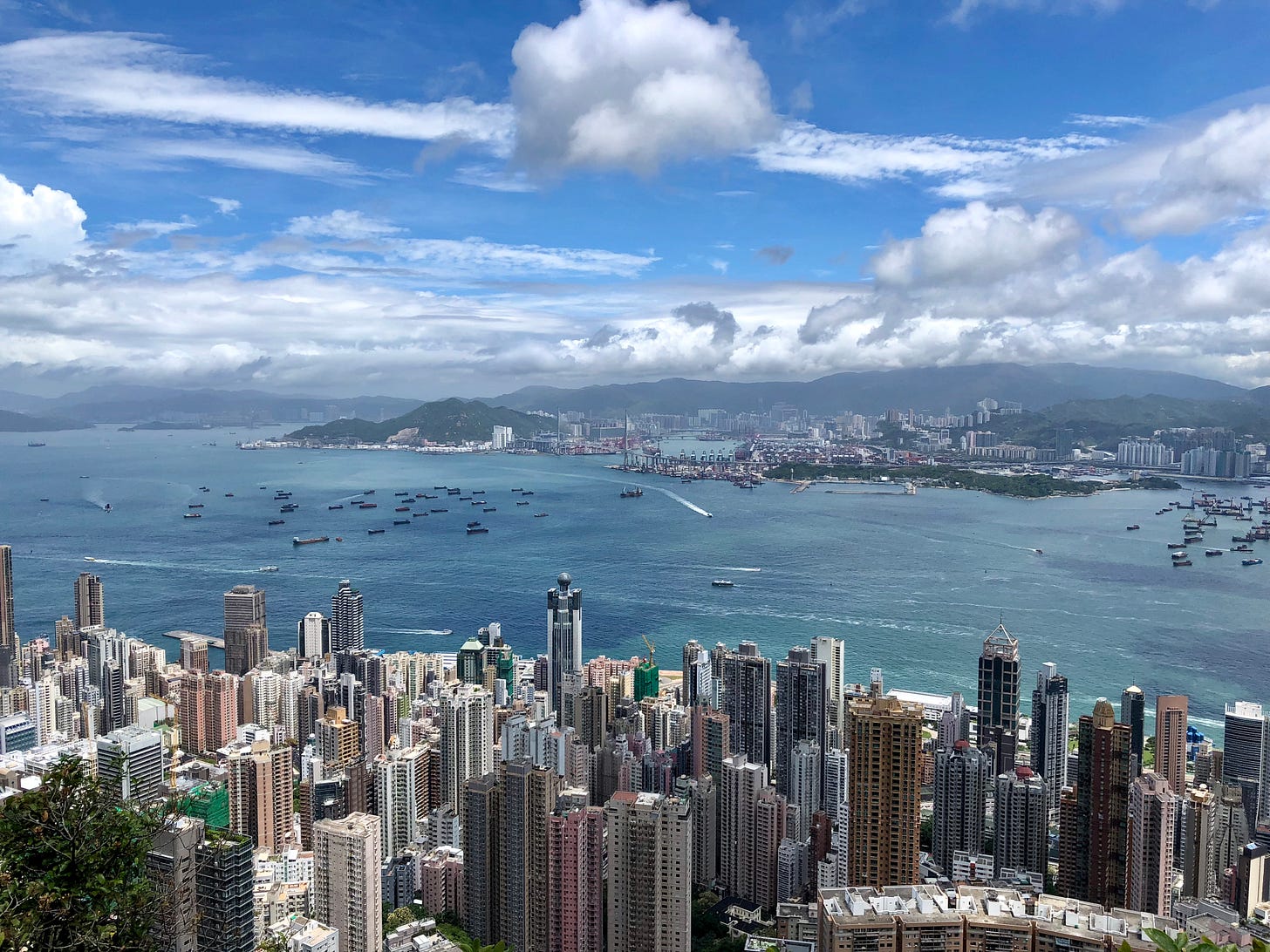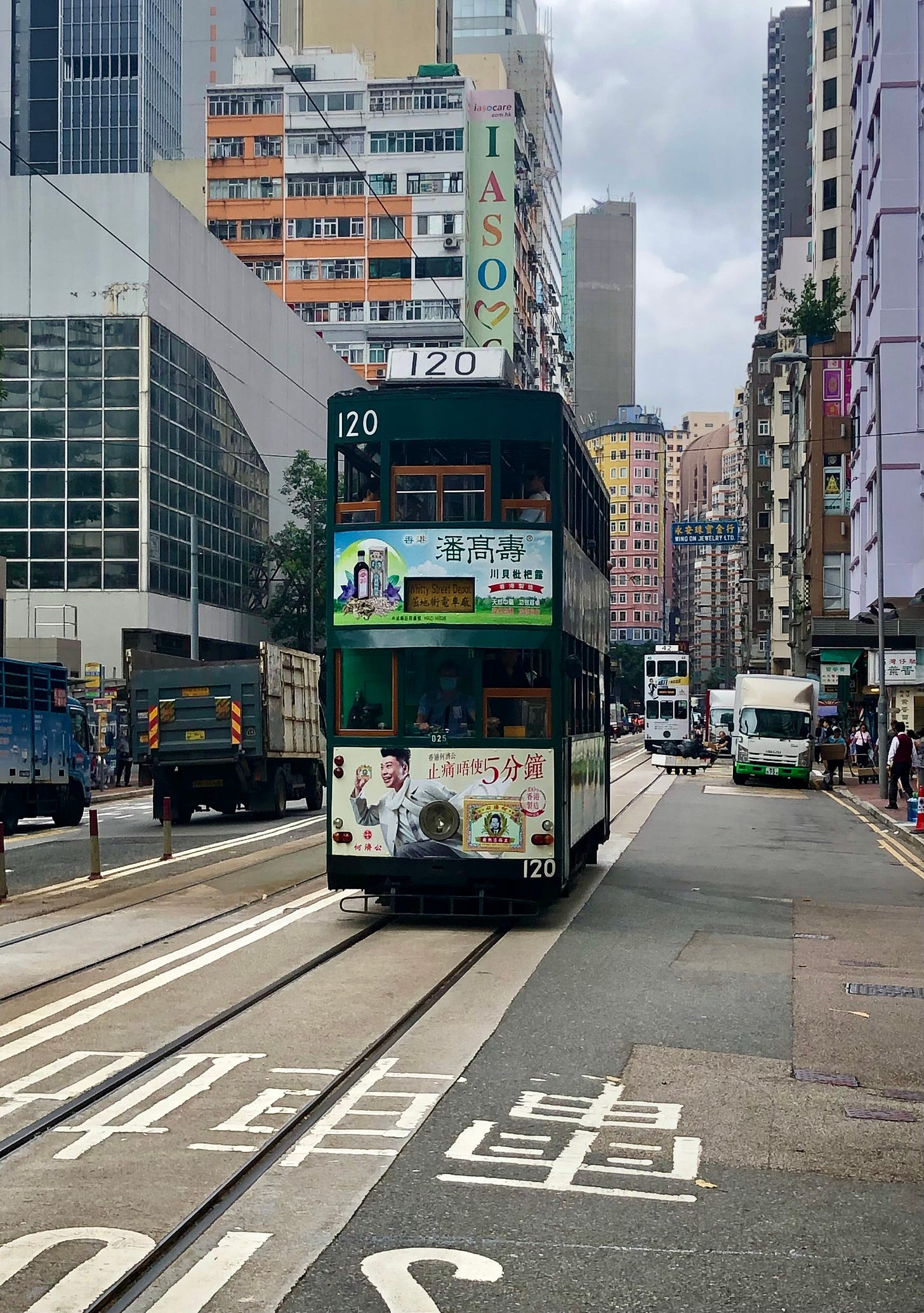In February, one of my best friend’s in the UK reached out to say that his sister and her family were going to be visiting Hong Kong, and he asked if I would be interested in showing them around.
My response was an emphatic yes!
On the morning that we were due to meet, I opened the curtains and my heart sank. Ominous grey clouds obscured the skyline over Victoria Harbour, and intermittent periods of heavy rain was forecast throughout the day. The original plan had been to meet in Tsim Sui Tsui (TST) in Kowloon and hit some tourist spots like the Avenue of the Stars and Kowloon Park. This was all still possible, but it would have required some serious adjustment to ensure that I wasn’t sending them back to their hotel like drowned rats.
I offered a Plan B: Star Ferry to Central, and then the Mid-Level escalators to Tai Kwun - a former Police station and Prison that has been converted into a museum and art space.
Later, when we were sheltering in Tai Kwun my friend’s sister commented on how convenient Hong Kong was to get around despite the poor weather. I agreed.
But don’t just take mine and my friend’s sister’s word for it for how convenient the city can be. Recently, TimeOut announced that Hong Kong was voted as having the best public transport system in the world. And having lived here for several years but been fortunate enough to travel to other comparably-sized cities, I can attest to this. Public transport here is broadly accessible and affordable. So, along with the majority of people, I don’t own a car and instead, I take the train, bus, or tram.
Alternatively, I walk and it appears that I am in good company. In 2017, it was reported that the average step count in Hong Kong was ranked as one of the highest in the world (6,880 per day). But the city is convenient in other ways. Many parts (e.g., Central and Kowloon) are connected via shopping malls/office blocks and sheltered walkways like the Mid-Levels escalators. These are particularly helpful when it is hammering down with rain and/or during the oppressive periods of heat and humidity during the summer. Although not everyone is in the position of being able to find shelter when the weather turns. A lot more could be done to protect those who are working outside during a torrential downfall or from the blazing sunshine.
The joys of urban planning
Urban planning has long been an informal interest of mine. I know, it’s slightly random and I have zero academic/professional expertise in the area. But I am fascinated by the way in which space is used, and particularly public space - from parks, pavements, roads, and to the availability of benches.
If you can forgive this digression, part of this interest was cultivated during my two-year stint as a paper-girl when I was a teenager.
Besides the job acting as my introduction to paid employment, it also provided me with an opportunity to regularly get out into my neighbourhood. Although as a mostly self-absorbed and clueless teenager, I was less focused on what makes an area appealing or attractive (despite the relative affluence of the area where I grew up) because my thinking was more: How can I do my paper-round as fast as I can?
Having said that, there were some early signs that I had deeper questions bubbling away at the back of my mind, including; which streets had more pedestrian crossings and better pavements than others; and which areas had better lighting (yep, I was already thinking about my safety).
Hong Kong Land Inc.
When I have friends and family visit Hong Kong, one of the first things that they tend to mention is the use of space. Makes sense, and certainly, when you are walking about in the urban areas, it can feel like buildings sit atop one another like the tiers of a cake. Yet you can find public spaces and ‘sitting out’ areas, which typically consist of a few benches and perhaps a public toilet. Having grown up in the UK where you would be lucky to find a public toilet, then Hong Kong scores major points on providing spaces for bladder relief!
Like in a lot of cities, space is at a premium in Hong Kong. But the territory has a unique problem in that less than 7% of land is available for residential development for a population of around 7.4 million. Hence, despite a slowdown in Hong Kong property in recent years, the scarcity of land available for development means that the city still has some of the highest property prices and rents in the world, and almost half of residents live in public housing.
This scarcity is significant but it is not necessarily anything new. The British colonial government did not prioritise open spaces; and subsequently, private developers were (and perhaps are still) not incentivised to provide large amounts of public space. Although you could argue that this is true in other major world cities.
In recent years, there have been some adjustments to zoning regulations to improve the quantity and quality of outdoor public space in Hong Kong. This has included the redevelopment of waterfront promenades and the increase of land designated as parks. Some of these projects have also involved land reclamation like at West Kowloon Cultural District. But Hong Kong is not alone in doing this: Singapore’s land surface has grown by 25% due to land reclamation.
How to improve a city
During the pandemic, I came across an urban planning idea called the ‘15-minute city’ where “all of the necessities of daily life […] are located in a short 15-minute walk or bike ride from home”. Those necessities include things like shops, restaurants, and a doctor’s office, as well as public spaces like parks. Sounds good, right?
Well, not so good for some.
One of the criticisms of 15-minute cities is that they wouldn’t easily address structural inequalities related to economics and geography. So while this design may be good in principle, it is likely to be more advantageous for the urban wealthy, and subsequent investment is likely to prioritise affluent neighbourhoods.
And if you can forgive a second digression, there’s a whole world of conspiracy about 15-minute cities, where it is believed that policies promoting these (i.e., by building more pedestrian areas/bike paths and restricting car use) are really about controlling people. Naturally, part of this conspiracy is also linked to a supposed “war on drivers”.
You might not be surprised to learn that I disagree with the whole controlling people thing, but there is a valid argument that supports the previous point - 15-minute cities won’t work everywhere and won’t work for everyone. For example, whenever I visit the USA, I am constantly reminded of how much the car is very much king because of how many areas have developed with the vehicle at the front and centre. It may take you at least 15-minutes just to get the car out and drive to the supermarket to buy some basics.
And stripping back some of this further, I am reminded of an interview that I listened to on BBC Radio 4’s Woman’s Hour several years ago1. Here, an urban planning researcher argued that we are more likely to use public spaces that provide opportunities for social engagement, that feel safe, and are convenient and accessible. While investment would be required to make certain improvements such as to lighting and widening entrances to a park for instance, but she stressed that these sorts of changes could provide lasting benefits for a community2.
Making public space accessible (again)
There is another reason for my interest in urban planning: my dad is visually-impaired. Consequently, I grew up with a degree of awareness of the importance of accessibility when it comes to public space, and how much of our world was not designed for those who may have additional needs. For example, from my dad’s perspective having vehicles parked all over public rights of way like pavements are about as helpful as someone suddenly stopping to check their phone. Although both of these things aren’t particularly helpful to anyone!
Hong Kong is not perfect when it comes the provision of public space, especially when the majority of the population have little to no outdoor space to call their own. But whenever I am out and about in the city, I still find myself pleasantly surprised by how many people are using what is available, from playing pick-up basketball in a park; running along the harbour front; or people just sitting and chatting. And there are benches, usually lots of benches.
Quality public spaces can support physical and mental health, but they can also provide us with a sense of belonging. I didn’t appreciate the importance of this when I was a teenager and when I was doing my paper-round, but I certainly do now.
One final thing!
An interesting development on HK Island are the plans to create a ‘Round-the-Island Trail’. I’d like to tackle parts of this over time, but visitors may have to show themselves around!
Unfortunately, I don’t have a link for this. But the central ideas stuck with me.
Last year, I wrote about ‘Third Spaces’. These are public areas that support civic engagement.








I adore how I keep finding things we have in common. I often joke w/ the hubby about how I should have been a city planner! Maybe we just have critical eyes, but seriously, it comes down to the winning combination of practicality and idealism.
We, too, walk and use public transportation, but Cambodia does not have HK's awesome planning or development. Nevertheless, it really wouldn't take much for the country to go solar and plant more trees for shade. The difference is huge - shade vs full sun. And we keep getting power outages, which I'm assuming is due to everyone using the AC.
When can we take over the development, eh?
The Round-the-Island trail looks amazing! What a great way to explore different areas.